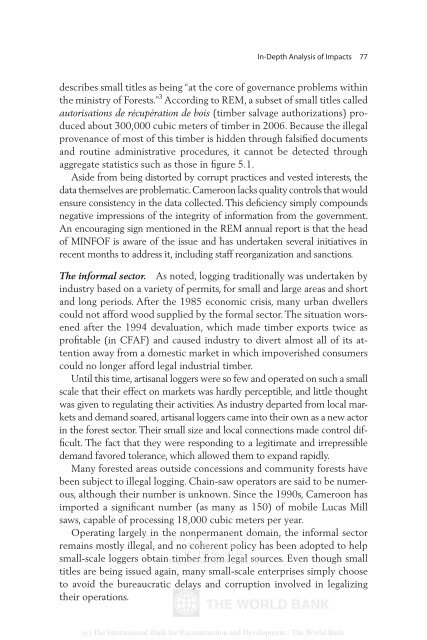The Rainforests of Cameroon - PROFOR
The Rainforests of Cameroon - PROFOR
The Rainforests of Cameroon - PROFOR
- No tags were found...
You also want an ePaper? Increase the reach of your titles
YUMPU automatically turns print PDFs into web optimized ePapers that Google loves.
In-Depth Analysis <strong>of</strong> Impacts 77describes small titles as being “at the core <strong>of</strong> governance problems withinthe ministry <strong>of</strong> Forests.” 3 According to REM, a subset <strong>of</strong> small titles calledautorisations de récupération de bois (timber salvage authorizations) producedabout 300,000 cubic meters <strong>of</strong> timber in 2006. Because the illegalprovenance <strong>of</strong> most <strong>of</strong> this timber is hidden through falsified documentsand routine administrative procedures, it cannot be detected throughaggregate statistics such as those in figure 5.1.Aside from being distorted by corrupt practices and vested interests, thedata themselves are problematic. <strong>Cameroon</strong> lacks quality controls that wouldensure consistency in the data collected. This deficiency simply compoundsnegative impressions <strong>of</strong> the integrity <strong>of</strong> information from the government.An encouraging sign mentioned in the REM annual report is that the head<strong>of</strong> MINFOF is aware <strong>of</strong> the issue and has undertaken several initiatives inrecent months to address it, including staff reorganization and sanctions.<strong>The</strong> informal sector. As noted, logging traditionally was undertaken byindustry based on a variety <strong>of</strong> permits, for small and large areas and shortand long periods. After the 1985 economic crisis, many urban dwellerscould not afford wood supplied by the formal sector. <strong>The</strong> situation worsenedafter the 1994 devaluation, which made timber exports twice aspr<strong>of</strong>itable (in CFAF) and caused industry to divert almost all <strong>of</strong> its attentionaway from a domestic market in which impoverished consumerscould no longer afford legal industrial timber.Until this time, artisanal loggers were so few and operated on such a smallscale that their effect on markets was hardly perceptible, and little thoughtwas given to regulating their activities. As industry departed from local marketsand demand soared, artisanal loggers came into their own as a new actorin the forest sector. <strong>The</strong>ir small size and local connections made control difficult.<strong>The</strong> fact that they were responding to a legitimate and irrepressibledemand favored tolerance, which allowed them to expand rapidly.Many forested areas outside concessions and community forests havebeen subject to illegal logging. Chain-saw operators are said to be numerous,although their number is unknown. Since the 1990s, <strong>Cameroon</strong> hasimported a significant number (as many as 150) <strong>of</strong> mobile Lucas Millsaws, capable <strong>of</strong> processing 18,000 cubic meters per year.Operating largely in the nonpermanent domain, the informal sectorDelivered by <strong>The</strong> World Bank e-library to:remains mostly illegal, and no <strong>The</strong> coherent World Bank policy has been adopted to helpIP : 192.86.100.34small-scale loggers obtain Mon, timber 09 Nov from 2009 legal 17:06:18 sources. Even though smalltitles are being issued again, many small-scale enterprises simply chooseto avoid the bureaucratic delays and corruption involved in legalizingtheir operations.(c) <strong>The</strong> International Bank for Reconstruction and Development / <strong>The</strong> World Bank
















